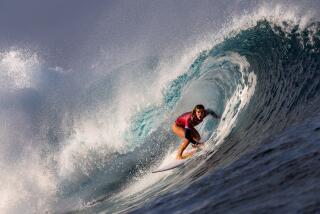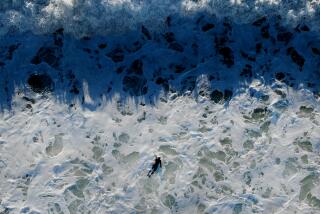FOR THE KIDS SURFING : Hanging 10 : A new book contains tips and lore on the sport. Author was aided by her husband’s 25-year collection of surfing magazines.
Is your kid nuts about surfing? Does he go out on dawn patrol with his buddies?
Does he gush about shooting the tube, shredding the wave, and that gnarly smoker that flung him over the falls?
If he--or she--is hooked on surfing, or merely anxious to give it a try, there is a new book out there tailored for youths.
“Cowabunga! The Complete Book of Surfing” tells about everything from surfing lore--early boards weighed as much as 200 pounds--to surfing etiquette--a surfer already on his feet has the right of way.
The book, selling for $9.95, was written by Lee Wardlaw, a Santa Barbara writer who has published seven novels for children and young adults.
She will be autographing books and talking with youths about her surfing guide on Saturday, from 1 to 2:30 p.m. at Adventures for Kids in Ventura.
Wardlaw, 35, doesn’t surf. She admits to it in the first sentence of the book. But her husband, Craig Jaffurs, has been riding the waves for 25 years, and he urged her to write something on the subject for youths.
“Nothing had been written for kids since the late 1960s,” she said recently. “Everything was hopelessly out of date. Surfboards had one fin, and swimsuits came above the bellybutton.”
Although not an expert on the sport, she went to the experts to research the book. She also found a gold mine of information in the mountains of surfing magazines her husband had collected during the past 25 years.
“I had been trying to get rid of them for the eight years we’ve been married,” Wardlaw said.
The most enjoyable section of the 164-page paperback is on the history of surfing and surfing heroes who brought the sport to its current popularity.
Polynesians surfed as early as 400 A.D., Wardlaw says in the book. The Polynesians brought the sport with them when they settled in Hawaii, where everyone rode the waves--kings, parents, children and grandparents.
Wardlaw’s book recounts one early spectacular feat of bravery: In 1868, a Hawaiian native surfed a tidal wave. The man was inside his home when the backwash from the giant wave swept him out to sea. He ripped a rafter from his house and rode the returning wave to shore. Some witnesses said the wave was as tall as a 10-story building.
Early California surfers lugged heavy boards to the beach, and to stay warm in chilly waters they wore bathing caps and wool sweaters. Few women surfed, but Wardlaw chronicles the success of one real-life Gidget, Margo Oberg, a one-time Santa Barbara resident who won the Women’s World Championship seven times. Wardlaw also spotlights current surfing heroes.
The book touches on the surfing music and movies of the 1960s. Wardlaw also has a chapter on avoiding shark attacks. (One tip: paint two mean-looking eyes on the bottom of the board.)
She explains the different types of boards, how they are made, wet suit construction, and the locations of surfing hot spots. (One is the Rincon, below Carpinteria.)
She has lists of surfing organizations, schools and camps. Charlie’s Off the Lip Surf School is in Camarillo. She also has put together a glossary of surfing terms and their definitions. (Free fall? When a surfer tumbles off the top of a wave.)
What she hasn’t included is a how-to section for beginners who want instruction.
“It’s difficult to learn to surf by reading a book,” Wardlaw said.
But more than that, her surfing experience is limited to a few rides as a teen-ager and a few more in Hawaii about 10 years ago.
“I’m not a great surfer,” she said. “I didn’t feel I should teach kids to do it.”
Her book is more of an overview on the subject with eight awesome color photographs of surfing.
Although the book is geared to teen-agers, she doesn’t talk down to them, and the book is enjoyable for adults.
One of her goals in writing the book was to give surfing the positive reputation it deserves, she said. Surfers of the 1960s carried the stigma of being lazy, dimwitted drug users.
“These people are athletes,” she said. The sport calls for upper-body strength to paddle through the water, stamina, and the grace and balance of a dancer, she said.
Although she didn’t spend her teen-age years on a surfboard, Wardlaw grew up living at the beach and body surfing.
A Santa Barbara resident since she was 4, she taught elementary school for five years. Then nine years ago she quit to write children’s fiction.
“I’ve been writing since I was 7,” she said.
Her most recent novel, “Corey’s Fire,” was based on the 1977 Sycamore Canyon fire that destroyed her family’s Montecito home and many others.
The book has sold more than 100,000 copies and this year was named one of the best books for reluctant readers by the American Library Assn.
Wardlaw and her husband have no children, but they dote on two cats. From their home they have a scant view of the ocean where she got her first taste of surfing as a youngster.
Why didn’t she become an avid surfer? “Not as many girls were doing the sport then,” she said. “I didn’t have enough role models.”
She isn’t likely to take it up now. She wiped out badly during her last surfing venture in Hawaii.
“The older I get the more I realize what can happen to you,” she said. “You should try it when you are young.”
* WHERE AND WHEN
Lee Wardlaw, author of the new book “Cowabunga! The Complete Book of Surfing,” will autograph the book and talk to youngsters Saturday, 1 to 2:30 p.m., at Adventures for Kids book store, 3457 Telegraph Road, Ventura.
More to Read
Sign up for our Book Club newsletter
Get the latest news, events and more from the Los Angeles Times Book Club, and help us get L.A. reading and talking.
You may occasionally receive promotional content from the Los Angeles Times.







